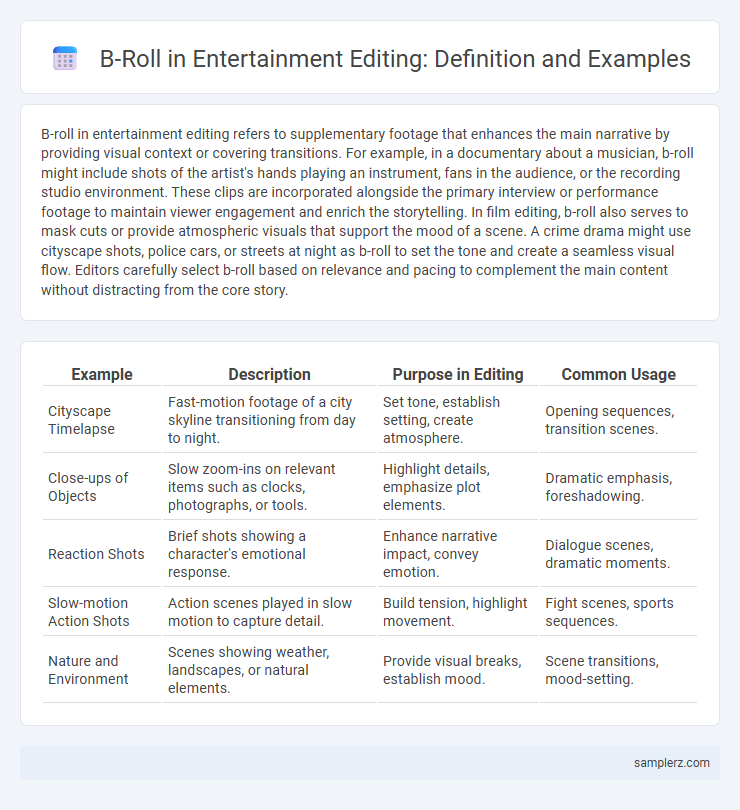B-roll in entertainment editing refers to supplementary footage that enhances the main narrative by providing visual context or covering transitions. For example, in a documentary about a musician, b-roll might include shots of the artist's hands playing an instrument, fans in the audience, or the recording studio environment. These clips are incorporated alongside the primary interview or performance footage to maintain viewer engagement and enrich the storytelling. In film editing, b-roll also serves to mask cuts or provide atmospheric visuals that support the mood of a scene. A crime drama might use cityscape shots, police cars, or streets at night as b-roll to set the tone and create a seamless visual flow. Editors carefully select b-roll based on relevance and pacing to complement the main content without distracting from the core story.
Table of Comparison
| Example | Description | Purpose in Editing | Common Usage |
|---|---|---|---|
| Cityscape Timelapse | Fast-motion footage of a city skyline transitioning from day to night. | Set tone, establish setting, create atmosphere. | Opening sequences, transition scenes. |
| Close-ups of Objects | Slow zoom-ins on relevant items such as clocks, photographs, or tools. | Highlight details, emphasize plot elements. | Dramatic emphasis, foreshadowing. |
| Reaction Shots | Brief shots showing a character's emotional response. | Enhance narrative impact, convey emotion. | Dialogue scenes, dramatic moments. |
| Slow-motion Action Shots | Action scenes played in slow motion to capture detail. | Build tension, highlight movement. | Fight scenes, sports sequences. |
| Nature and Environment | Scenes showing weather, landscapes, or natural elements. | Provide visual breaks, establish mood. | Scene transitions, mood-setting. |
Defining B-Reel: An Introduction
B-Reel in editing refers to secondary footage that complements the main shots, often used to enrich storytelling and provide visual variety. This type of footage includes cutaways, reaction shots, and supplementary scenes that enhance narrative depth without being the primary focus. Editors rely on B-Reel to maintain viewer engagement and create seamless transitions within films, TV shows, and digital content.
The Purpose of B-Reel Footage in Storytelling
B-reel footage enhances storytelling by providing supplementary visual elements that enrich the narrative, such as background actions or environment shots that establish context. It helps create seamless transitions and maintain pacing by filling gaps between main scenes, ensuring a coherent flow. This secondary footage deepens audience engagement by adding layers of meaning and emotional texture beyond the primary storyline.
Types of B-Reel Shots Commonly Used
B-reel shots commonly used in entertainment editing include establishing shots, close-ups, reaction shots, and cutaways, all designed to enhance narrative flow and visual interest. Establishing shots set the scene, while close-ups emphasize emotion or detail, reaction shots capture character responses, and cutaways provide relevant context or bridge scenes smoothly. These types of B-reel shots contribute significantly to pacing and storytelling dynamics in film and television production.
Enhancing Visual Narratives with B-Reel
B-reel footage enriches visual storytelling by providing supplementary angles, behind-the-scenes moments, and contextual details that elevate the main narrative. Editors integrate B-reel clips to create seamless transitions, highlight emotional nuances, and deepen audience engagement through layered imagery. Strategic use of B-reel content transforms standard edits into immersive experiences, enhancing the overall impact of entertainment projects.
B-Reel Techniques in Documentary Editing
B-Reel techniques in documentary editing involve integrating supplementary footage such as archival clips, atmospheric shots, and secondary interviews to enrich the narrative. This approach enhances storytelling by providing visual context and emotional depth, often utilizing montage sequences and juxtaposition to emphasize thematic elements. Skilled editors balance B-Reel content with primary footage, maintaining pacing while offering viewers a layered viewing experience.
Leveraging B-Reel for Seamless Transitions
B-reels in editing enhance narrative flow by providing supplementary footage that bridges primary shots, creating seamless transitions. By integrating B-reel clips such as reaction shots, establishing shots, or cutaways, editors maintain visual continuity and audience engagement without abrupt cuts. This technique leverages the flexibility of B-roll to enrich storytelling and smooth temporal or spatial shifts in entertainment content.
How B-Reel Elevates Emotional Impact
B-Reel expertly amplifies emotional impact in editing by seamlessly integrating behind-the-scenes footage and candid moments that reveal genuine human experiences. Their approach combines dynamic visuals with nuanced sound design to deepen viewer connection and evoke empathy. This technique transforms standard storytelling into emotionally resonant narratives that captivate audiences.
Using B-Reel for Expository Sequences
B-reel footage enhances expository sequences by providing complementary visuals that enrich storytelling without interrupting the narrative flow. Editors integrate B-roll clips demonstrating relevant actions, environments, or reactions, which clarifies complex information and maintains viewer engagement. This technique is essential in documentaries, corporate videos, and instructional content where seamless explanation and visual appeal must coexist.
B-Reel Best Practices in Film and TV
B-Reel excels in seamless integration of behind-the-scenes footage and creative montages, enhancing narrative depth in film and TV editing. Their best practices include precise pacing, visual consistency, and innovative transitions that maintain audience engagement throughout dynamic sequences. This approach ensures a polished, immersive experience that supports storytelling while showcasing artistic craftsmanship.
Iconic B-Reel Examples in Modern Cinema
Iconic B-reel examples in modern cinema include the elaborate chase sequences in "Mad Max: Fury Road," where explosive cuts and dynamic angles heighten tension. The rhythmic montage of destruction in "Inception" showcases B-reel footage as a powerful tool for storytelling through visual layering. Quentin Tarantino's use of flashy B-reels in "Kill Bill" creates a stylized narrative texture that emphasizes action and character flair.

example of b-reel in editing Infographic
 samplerz.com
samplerz.com